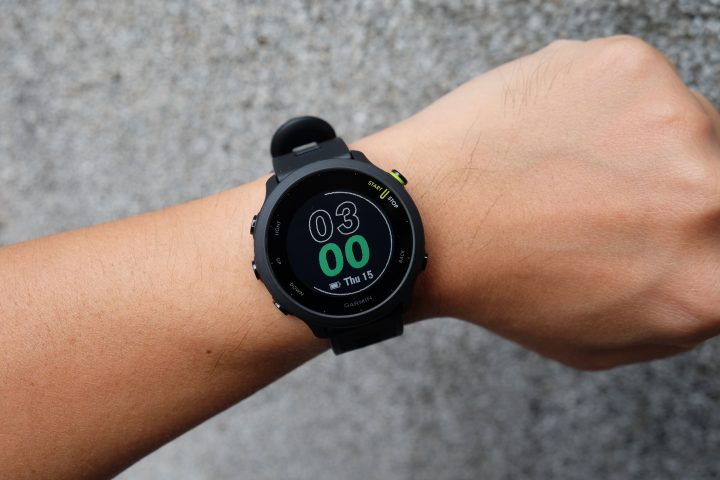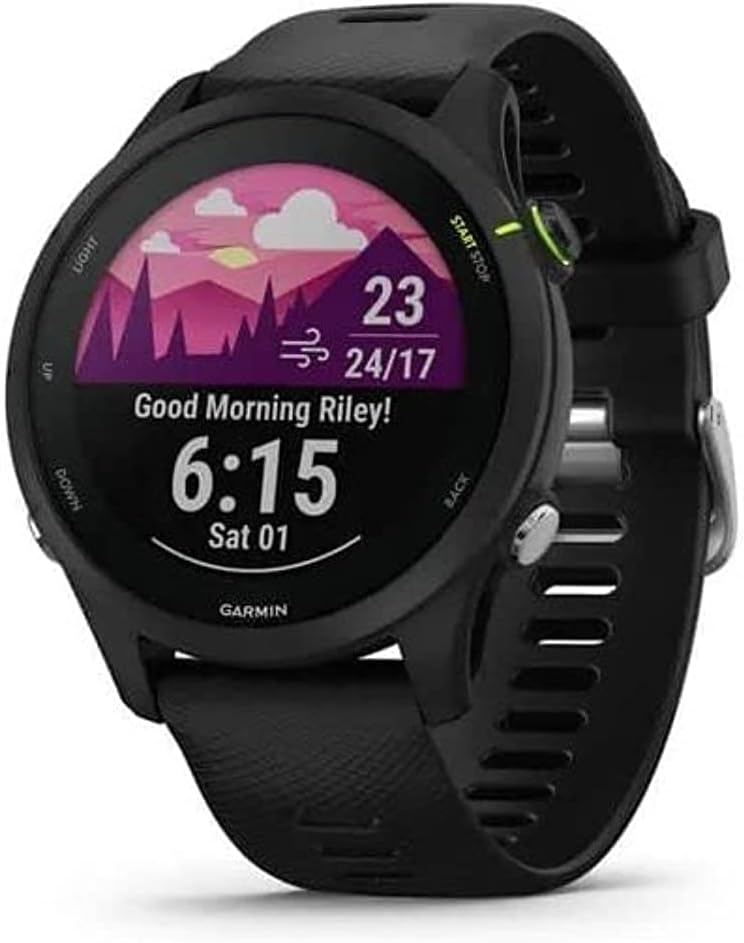Let’s be honest—finding a good running watch can be just as frustrating as hitting a training plateau. You think you know what you need, but then you start comparing features and get completely lost. That’s what happens when you’re stuck between two Garmins like the Forerunner 55 and the Forerunner 255. One is minimalistic and no-fuss, the other feels like it swallowed half the features of a top-tier multisport device.
We’ve spent plenty of hours with both on the wrist. The 55 feels like that trusty old gym buddy who’s always there when you need them. The 255? That’s the overachiever who brings protein bars to the track and logs every rep in a spreadsheet. Two very different vibes—and different expectations. So if you’re caught in the middle, wondering which one suits your runs, your lifestyle, and your obsession with VO2 max, we’ve got you covered. Let’s get into it.
Design that actually gives you a choice

You might not spot the differences immediately, especially if you’re glancing from across the table at a cafe. Both watches carry that Garmin DNA—five physical buttons, a round face, and a practical, sporty aesthetic. But once you strap them on, it’s a different story.
The Forerunner 255 comes in two sizes: 46mm and 41mm. That already makes it feel more inclusive—whether you’ve got slimmer wrists or prefer a larger display. The Forerunner 55, on the other hand, comes only in one 42mm option. Not a dealbreaker, but if you’re picky about size, you’ll notice.
And then there’s the screen. The 255 offers a 33mm display in its larger version, while the 55 sticks to 26.3mm. It sounds small on paper, but in real-world use, it changes how you read your metrics mid-run. Especially when you’re gasping for air and trying to see your pace without squinting.
Resolution is sharper on the 255 across the board, making graphs, maps, and text way more legible. We’re talking about a smoother visual experience—even though neither model is touch-based. Yes, both use the same silicone bands and Garmin’s quick release system, but the 255 just feels more polished in every corner.
Battery life that doesn’t quit halfway
Battery life used to be the Achilles’ heel of smartwatches. Not anymore. These two Garmins are stamina champs—but there are still some differences that matter depending on how you train.
The Forerunner 55 clocks in with a maximum of 14 days in smartwatch mode. That’s already above average. But the Forerunner 255 (in its larger version) gets pretty close, offering up to 14 days as well, and the smaller one trails just slightly behind at 12.
Now let’s flip to GPS mode. Here’s where things get more interesting. Both the 55 and the 255S give you about 20 hours, which covers anything short of an ultra. But the larger Forerunner 255 stretches to 25 hours of GPS runtime. For marathoners or long-distance cyclists, that’s golden.
Of course, music playback changes the game. If you opt for the 255 Music version, you’ll get around 6.5 hours of battery life with GPS and music streaming, which is still solid for race day playlists.
From simple tracking to a full-blown fitness lab
If you’re just starting out or prefer not to overthink every stride, the Forerunner 55 delivers all the essentials. It tracks runs, rides, swims, heart rate, sleep, stress, and more. You’ll also find Garmin classics like PacePro and suggested daily workouts baked right in.
But then you switch to the 255 and things escalate quickly. It’s equipped with the Elevate V4 sensor, Garmin’s latest optical heart rate tech. That means you’re getting not just heart rate but Pulse Ox (blood oxygen), HRV (heart rate variability), respiration rate, and other stats that dive deep into your physiology.
The 255 adds advanced tools like the Morning Report, Acute Load, and Health Snapshot. That’s the kind of stuff that helps you train smarter, not just harder. You’re not just counting steps—you’re analyzing recovery time, training effect, and how your last workout impacted your readiness for the next one.
And for triathletes? The 255 isn’t just helpful—it’s essential. It has dedicated triathlon modes, something the Forerunner 55 simply can’t offer.
Going beyond notifications

Both watches keep you updated with the basics: texts, calls, calendar alerts, and weather. Nothing groundbreaking, but enough to keep you connected without pulling out your phone every ten minutes.
But if you go for the Forerunner 255 Music, everything changes. You can download playlists from Spotify, Deezer, or Amazon Music and stream them directly through Bluetooth headphones. No phone needed. And when you’re trying to go minimalist for your morning 10K, that freedom feels pretty sweet.
Oh, and one more thing. Garmin Pay is only available on the Forerunner 255. It’s not life-changing, but when you’ve forgotten your wallet and desperately want a post-run smoothie, it can definitely save the day.
Sports profiles and who they’re made for
The Forerunner 55 plays it safe. It sticks to the fundamentals: running, cycling, swimming, and a few gym-related activities. That covers most needs for recreational athletes.
But with the 255, you unlock a library of sports modes, including trail running, skiing, HIIT workouts, and, most importantly, triathlon and multisport profiles. If you ever thought of combining workouts into one session—swim-bike-run, for example—the 255 handles it with zero fuss.
It also throws in smarter tools like “Up Ahead,” which shows you points of interest, aid stations, or custom course markers during a race. And then there’s recovery advice based on real-time physiological tracking. Not just “rest for two days,” but actual insights based on how you’re doing.
Navigating without drama

We’re used to touchscreens on everything now, but Garmin keeps its five-button setup for a reason—it works. Rain, sweat, gloves—none of it matters. You can still navigate without missing a beat.
But even with identical button layouts, the 255 feels faster. Menus load quicker, animations are smoother, and the UI feels a bit more polished. It’s not night and day, but it’s like switching from an older phone to a newer one. Same OS, just more fluid.
The improved screen also plays a part here. The higher resolution makes everything easier to digest at a glance, whether you’re browsing history or adjusting your intervals mid-run.
Built to get roughed up
Garmin knows we’re not just sitting at desks with these watches. So both models come prepared for sweat, rain, pool sessions, and accidental drops. Water resistance goes up to 5 ATM on both, which means they’re fine for swimming and showering.
The Forerunner 55 is lighter, and it almost disappears on the wrist after a while. That’s a big plus for all-day wear. But the 255, despite being slightly thicker and heavier, is still super wearable—even for sleep tracking.
And don’t forget about the interchangeable bands. Pop off the workout band, snap on something more neutral, and the watch goes from treadmill to meeting in five seconds.
Same app, different experience
Both watches sync with Garmin Connect, which is powerful but definitely has a learning curve. Once you’re in, though, it’s a data paradise.
The difference is that the Forerunner 255 feeds the app a lot more to work with. You get training readiness scores, sleep stage breakdowns, and long-term load analysis. The 55? It gives you the basics, but it can’t dig as deep.
And if you’re into third-party apps like Strava or TrainingPeaks, both watches play nice—but the extra data from the 255 makes your integrations way more meaningful.
More ways to make it yours

Everyone likes a little customization. The 55 does a decent job—you can swap watch faces, adjust data screens, and tweak a few settings.
But the 255 takes it further with full Connect IQ support, which means more apps, more widgets, and more ways to fine-tune the experience. Want a race countdown widget? You’ve got it. A weather radar? No problem. Data-heavy screens that show lactate threshold and vertical oscillation? Yep.
It feels like you’re not just wearing a watch—you’re curating a tool.
So… is the Forerunner 255 worth it?
Okay, we’re not going to sugarcoat it. The Forerunner 55 is great—especially if you’re just getting into running or want something light, simple, and no-frills. It does its job, and it does it well. You’ll stay on track, stay safe, and build a routine.
But once you try the 255, it’s hard to go back.
The jump in features feels less like an upgrade and more like stepping into a different category of watch. Triathlon support, deeper physiological tracking, more sports modes, music playback, Garmin Pay—it’s like going from a flip phone to a smartphone.
The only catch? You might not use everything at first. It can feel like overkill if you’re not training seriously. But if there’s even a slight chance you’ll want to take things up a notch someday, the 255 gives you room to grow.
We didn’t expect to feel such a difference between two watches that look so alike at first glance. But the 255 just feels smarter, sharper, and more prepared for anything you throw at it. The 55 is dependable—but the 255 is ambitious. And maybe that’s exactly what your training needs right now. Or maybe not. But then again… maybe it is.


